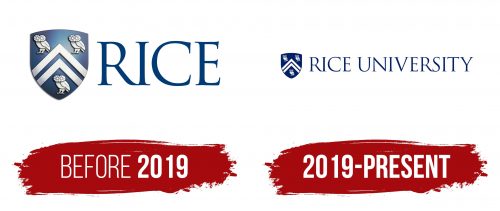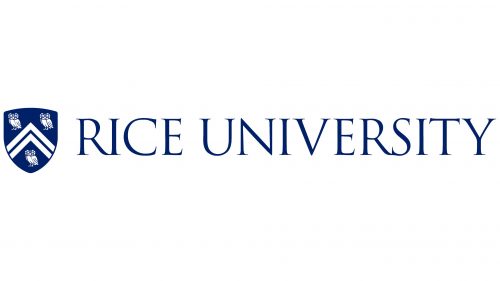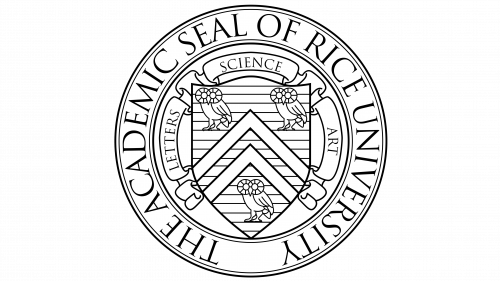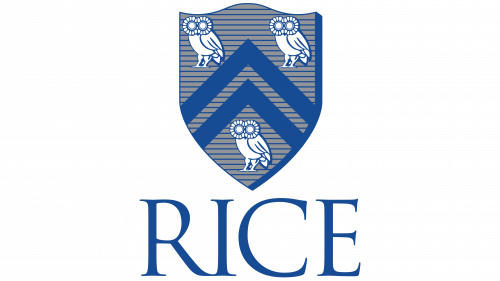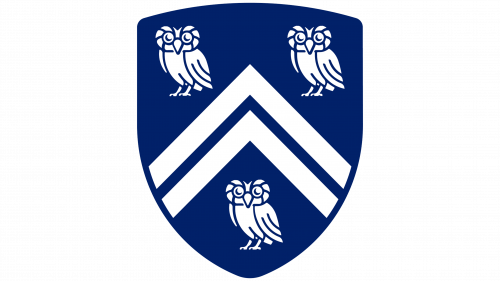The Rice University logo reflects the most important thing – inner wisdom. It also signifies self-realization, luck, intuitive development, transformation, and change. This is important for an educational institution that ranks top and produces well-prepared specialists. The elements gathered in the emblem represent the main historical heritage.
Rice University: Brand overview
| Founded: | September 23, 1912 |
| Founder: | William Marsh Rice |
| Headquarters: | Houston, Texas, United States |
| Website: | rice.edu |
Meaning and History
The question of what the new university in Houston would be named was never raised. It was clear to everyone that it would bear the name of the one who aspired to its opening and paid for it with his life. Businessman William Marsh Rice left a will to build a free university with high educational status but died from the intrigues of a relative who coveted his fortune. Thus, in 1912, Rice University opened its doors.
The entire visual identity of the university is built around the image of a historical shield with an Athenian owl. The chevrons are the coats of arms of 16 families bearing the surname Rice and associated with Houston. Therefore, the shield is the brand’s key and most recognizable element. It is supplemented with a verbal sign – an original typographic inscription developed based on the Trajan font. The main task of the emblem is to convey the aspiration for self-development, wisdom, and influence. Its developer is Pierre de Chaignon la Rose of Cambridge from Massachusetts.
What is Rice University?
Rice University is an American educational institution of the highest category – R1. It appeared in 1912, built on the funds of local businessman William Marsh Rice – a real estate trader, cotton, and owner of a railroad laying company. The university consists of eight schools: continuing education, business, architecture, music, and engineering, as well as social, humanities, and natural sciences. It has its own sports department, whose participants compete in 14 types of sports. The location of the educational institution is the city of Houston, Texas.
before 2019
The key detail of the logo is a heraldic shield proposed in 1912 by Pierre de Chaignon la Rose of Cambridge. It consists of three corners and two roundings at the bottom. Almost all the space is occupied by Athenian owls, which have adorned the emblem since the university’s inception.
These are incredibly important details because they show the university’s historical roots, demonstrate its connection with the locality, and pay tribute to the founder of the educational institution. They are taken from the family coats of arms of Houston families. Two birds are at the top and one at the bottom. Between them is a right angle, pointed upwards. Two wide lines form it. The owls have a shadow, which makes them voluminous, and the shield has a sheen.
To the right is a single-line inscription executed in an individual font. All letters are uppercase, bold, high, and decorated with thin serifs resembling spikes. At the base, the glyph is wider than at the end. The right leg of the “R” is so elongated that it touches the neighboring “I.” The text is colored in blue.
2019 – today
Designers have turned the three-dimensional shield into a flat one. This was necessary so that clear lines and simplicity allowed the logo to be used in typography, on websites, patches, in stencil printing, and without distortion, conveyed on the displays of modern devices. The shield, Athenian owls, and the rectangle dividing them are now reduced in size. Birds and stripes have become white, the shield – blue. There are no shadows, glares, or light transitions.
The university’s name remains on the right side, but now it’s complete – “Rice University.” The font has been slightly modified, becoming a modern version of the Trajan typeface with Roman uppercase letters and sharpened serifs. At the junction of “R,” there’s a fusion with “I” and “S.” The other glyphs are placed at a slight distance from each other; however, the spacing between them is minimal.
The Seal
The entire visual identity of this higher educational institution is based on the shield and the Athenian owls, including the academic seal. It was approved in 1912 when it was first introduced by Pierre de Chaignon la Rose of Cambridge. The graphic artist pursued two goals: to show the university’s connection with the place where it is located and to emphasize the importance of education. After all, owls are not just a heraldic image. They also embody wisdom, knowledge, honor, luck, and self-realization.
The drawing is done with thin black lines on a white background. There’s no other color palette provided in the official symbol. The shield with three owls and a geometric figure with a right angle is located in the center. Also, horizontal stripes are running from top to bottom. Around them are curved tapes with the university’s slogan: “Letters, Science, Art.” There are several framing rings, including one wide one with the inscription “THE ACADEMIC SEAL OF RICE UNIVERSITY.” The frame is thin.
Font and Colors
The word part of the university logo and seal are made in bold upper case. The letters are Roman: they have thin serifs. This style is reminiscent of the Trajan typeface, which underlies Rice University’s identity.
The palette is restrained, few, and not bright – just the kind to convey the seriousness of the educational process. It is represented by four colors: navy blue, silver, black, and white.

